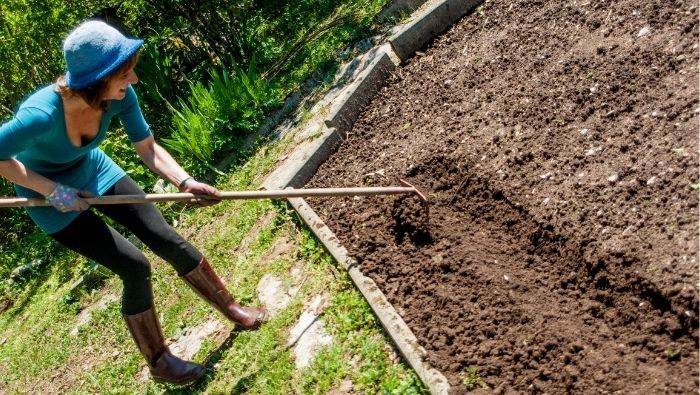Raised Garden Beds on the Cheap

The materials needed for raised garden beds can get costly. Here is how to have raised garden beds on a small gardening budget.
Raised beds can be expensive to make.
By the time you add together the cost of landscaping timbers, soil, compost or manure, you can easily spend over $75 to $100 or more per bed. If you plan to have a large garden, the costs quickly mount up.
Here is how to have raised beds in your garden for very little or no money.
9 Steps to DIY Raised Garden Beds
Raised garden beds take time and work to create, but going the DIY route can be well worth the money you’ll save.
1. Start early.
It is best to start the process several weeks or months before you wish to plant the beds. Creating the beds in autumn for spring planting is perfect.
2. Determine where your raised beds will go.
First, measure off the area where you wish to put the bed. Don’t make the bed so wide that you can’t easily reach across it. You can make the bed a classic rectangular shape, or you can make it an irregular shape to fit into a niche in your yard.
3. Remove any sod or weeds where the bed is to be prepared.
You can loosen the soil a bit, although this step is not strictly necessary. However, loosening the soil does encourage earthworms and soil microbes to go up into the bottom layer of the bed and provides better drainage.
Sign Up for Savings
Subscribe to get money-saving content by email that can help you stretch your dollars further.
Twice each week, you'll receive articles and tips that can help you free up and keep more of your hard-earned money, even on the tightest of budgets.
We respect your privacy. Unsubscribe at any time.
4. Create a border if you want one.
You can create a border out of repurposed materials for your garden bed, but a border is not necessary.
5. Cover the ground with compostable matter.
Next, gather grass or other green compostable matter and cover the ground where the bed will be to a depth of about 12 inches. I have a weak-stemmed native grass that grows in my yard that I used. You can also use vegetable peelings and other compostable scraps from the kitchen.
6. Add a layer of newspapers or cardboard.
Over the layer of green matter, spread newspapers and cardboard about 1/4 to 1/2 inch thick. Once spread, wet them down so that they are evenly moist. This layer will suppress any weeds that emerge from the ground or the compostable material.
7. Add a layer of compost or topsoil and a layer of mulch.
Now, spread an inch or two of compost or topsoil over the newspaper layer. Last, spread a three to six-inch layer of mulch over the top of the bed. You can use leaves, straw, pine straw, or any mixture of mulching materials. Water the bed well so that all layers are moist.
8. Leave the bed alone for a few weeks to a few months.
This will give the green matter on the bottom of the bed a chance to decompose into compost.
9. Plant your seeds or plants.
When you are ready to plant the bed, simply move the mulch aside and place your seeds or plants in the soil underneath. The layer of newspaper will have decomposed enough that the roots of the plants can grow down into the layer of compost on the bottom of the bed.
My Experience Making Raised Garden Beds
I made two of these beds in my yard last fall. I find they hold moisture best of all the garden areas I have, whether a conventional raised bed or an area tilled and amended with organic matter.
I got more lettuce from one bed than I’ve ever gotten from a similar-sized garden bed. And the lettuce kept bearing well into our warm weather, far past the time it would typically have bolted. I’m convinced that this is because of all the moisture retained in the bed.
The only possible downside to creating garden beds like this is the lack of defined boundaries. This should not be a problem if your household consists of adults and older children. Pets and very small children might need to be gently reminded that the garden beds are not to be walked on.
One dog continually walked in the bed where we had planted strawberries this spring and the other dog took naps there. In retrospect, we should have put up stakes or some other type of barrier around the bed until the dogs learned to stay out of the bed.
These new raised beds cost me nothing for materials. I had all the green matter for the bottom layer in my yard. All I had to do was pull it up. I had the newspapers on hand, ready to recycle. It’s true that I had to pay for the newspaper subscription, but we were taking the paper anyway. And I could have asked a neighbor to save papers for me.
The compost and dirt were from our compost piles and dirt that had washed down into our yard from the neighbor’s yard. The mulch was raked up from my yard. I avoided spending money on mulch, soil, landscaping timbers and gas to go to the garden center, and the result has been very productive garden spaces.
Reviewed October 2023
Wouldn't you like to be a Stretcher too?
Subscribe to get our money-saving content twice per week by email and start living better for less.
We respect your privacy. Unsubscribe at any time.
Popular Articles
- 7 Habits of Highly Frugal People
- 5 Simple Budget Cuts That Can Save $200 a Month
- How to Track Down Unclaimed Funds Owed You
- 32 Ways to Save Money on Your Utility Bills
- Do You Need Credit Life Insurance When Buying a New Car?
- How to Maximize Profits When Selling Online
- Staying Motivated to Continue Digging Yourself Out of Debt
On After50Finances.com
- 9 Things You Need to Do Before You Retire
- You Didn’t Save Enough for Retirement and You’re 55+
- When Empty Nesters Reorganize and Declutter Their Home
- Reinventing Your Career in Your 50s or 60s
- What Mature Homeowners Should Know about Reverse Mortgages
- 2 Reasons to Collect Social Security Benefits As Soon As Possible

